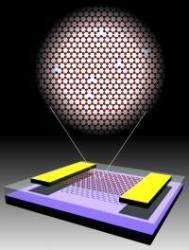A team led by the Physics Professor Michael S. Fuhrer of the UMD Center for Nanophysics and Advanced Materials at University of Maryland have devised a method to monitor magnetic properties of graphene that could lead to magnetic storage and magnetic random access memory applications.
The team has discovered that missing atoms or vacancies in graphene, display magnetic moments that react to the electrons in graphene, causing enhanced electrical resistance at low temperature, known as the Kondo effect. The research paper, "Tunable Kondo effect in graphene with defects," has appeared in the recent edition of Nature Physics.
 UMD's Graphene Transistor
UMD's Graphene Transistor
The effect relates to adding nano quantities of magnetic metal atoms, including iron or nickel, to a non-magnetic metal, like gold or copper. The ideal temperature for the effect in graphene with vacancies was discovered to be as high as 90 Kelvin. The temperature can be adjusted by an electrical gate voltage.
Fuhrer anticipates that vacancies in graphene could be arrayed in a particular way to lead to ferromagnetism. Singular magnetic moments can be connected through the Kondo effect making them to align in the same direction.
The result would behave like iron but be fabricated from carbon. This magnetic force could cause nanoscale sensors featuring magnetic fields. Together with graphene's electrical properties, this magnetism could be used in spintronics. Fuhrer says this could lead to defect engineering in graphene such as removing atoms in appropriate places to create the desired magnetic properties.
The effort was funded by grants received from the National Science Foundation and the Office of Naval Research.